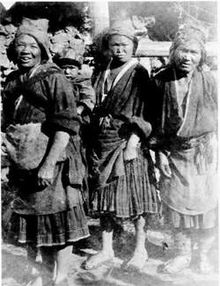The Tunbao or Tunpu (Chinese: 屯堡) are an ethnic subgroup of the Han, located in Guizhou and Yunnan provinces, China. The Tunbao are descended from ethnic Han who were part of an army sent on an expedition to Guizhou during the reign of the Ming dynasty's Hongwu Emperor.[1] Long thought to have been a non-Han ethnic minority, their Han origins were proved by Japanese anthropologist Torii Ryuzo in 1896. The Tunbao have preserved much of their culture, costumes, and language from the Ming era.[2]
 Tunpu women, 1920s | |
| Total population | |
|---|---|
| about 300,000 | |
| Regions with significant populations | |
| Anshun, Guizhou, China | |
| Languages | |
| Southwestern Mandarin | |
| Religion | |
| Chinese folk religion, Buddhism, Daoism | |
| Related ethnic groups | |
| Chuanqing people, Han Chinese (especially Hakkas) |
The Tianlong Tunbao town, located near Anshun[3] is a historic site where Tunbao homes and customs have been preserved, including the traditional Dixi opera or "ground opera" performances.[4]

References edit
- ^ Beijing Review. January 1997. p. 32. Retrieved 19 July 2013.
In the vicinity of Anshun, Guizhou Province in southwest China, are dozens of mystic villages where the Tunbao people still preserve China's Ming Dynasty (1368-1644) folklore.
- ^ Reader's Digest (26 June 2005). China, its most scenic places : a photographic journey through 50 of its most unspoiled villages and towns. Reader's Digest Association. p. 210. ISBN 978-0-7621-0620-2. Retrieved 19 July 2013.
Also found in the area are some three hundred Tunbao communities, literally the garrison fortress villages, with a population of approximately 300,000. The Tunbao inhabitants live in fortlike stone-and-wood houses on ...
- ^ "Tunpu culture in Anshun". Retrieved 8 August 2013.
- ^ "Tianlong Tunbao Ming Dynasty City". Retrieved 2013-07-19.